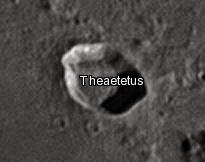|
Theaetetus (crater)
Theaetetus is a lunar impact crater that is located to the southeast of the crater Cassini near the eastern edge of Mare Imbrium. It was named after the ancient Greek mathematician Theaetetus. It lies just to the west of the Montes Caucasus range, which forms the eastern shore of the mare. To the southwest is the prominent crater Aristillus. The rim of Theaetetus is distinctly polygonal in shape, with a slight rounding at the vertices. There is a low outer rampart and a slight central rise on the crater floor, which is offset to the northeast of the crater midpoint. The interior is otherwise relatively featureless. This crater has been noted in the past as a site of possible transient lunar phenomena. In 1902, a white cloud was observed briefly in the vicinity of the crater. Other observers, including Patrick Moore and W. H. Pickering William Henry Pickering (February 15, 1858 – January 16, 1938) was an American astronomer. Pickering constructed and established seve ... [...More Info...] [...Related Items...] OR: [Wikipedia] [Google] [Baidu] |
Lunar Reconnaissance Orbiter
The Lunar Reconnaissance Orbiter (LRO) is a NASA robotic spacecraft currently orbiting the Moon in an eccentric polar mapping orbit. Data collected by LRO have been described as essential for planning NASA's future human and robotic missions to the Moon. Its detailed mapping program is identifying safe landing sites, locating potential resources on the Moon, characterizing the radiation environment, and demonstrating new technologies. Launched on June 18, 2009, in conjunction with the Lunar Crater Observation and Sensing Satellite (LCROSS), as the vanguard of NASA's Lunar Precursor Robotic Program, LRO was the first United States mission to the Moon in over ten years. LRO and LCROSS were launched as part of the United States's Vision for Space Exploration program. The probe has made a 3-D map of the Moon's surface at 100-meter resolution and 98.2% coverage (excluding polar areas in deep shadow), including 0.5-meter resolution images of Apollo landing sites. The first images f ... [...More Info...] [...Related Items...] OR: [Wikipedia] [Google] [Baidu] |

_launches_with_LRO_and_LCROSS.jpg)